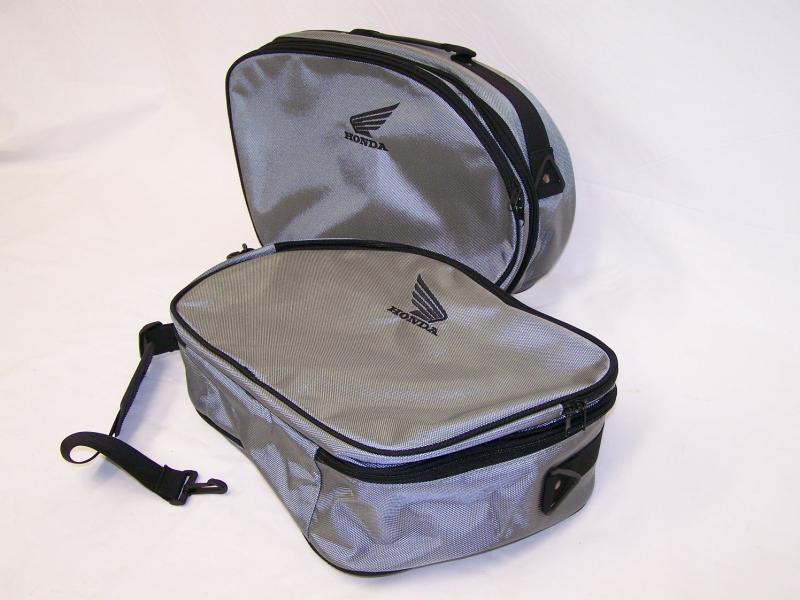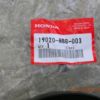-
Posts
641 -
Joined
-
Last visited
Content Type
Forums
Profiles
Gallery
Blogs
Downloads
Events
Posts posted by Darth Bling
-
-
My bike is dead stable at 130+ mph with saddlebags and a top-box, not that I've ever gone that fast before. :lurk:
The bag liners are a removeable bag you can use to quickly load and unload your saddlebags. They're actually very handy to have. I use mine all the time when I'm packing for a weekend trip.
Here are what they look like:

-
Yes, get rid of that tire. It definitely looks like the cords inside the tire are broken.
-
90° valve stems work just fine, if you get the correct ones.
Here's what veefer800cancuuk uses: http://www.motowheels.com/italian/myProduc...;categoryID=405
And, here's a link to Oyama's thread about 90° valve stems: http://www.vfrdiscussion.com/forum/index.p...st&p=474019
-
the bike does 5500rpm in 6th gear at 81mph, I dont see your going to gain anything , the vfr is already over geared for mpg
You gain about one to two MPG with a larger front sprocket.
With stock gearing, the 6th gen will do about 70 mph at 5000 rpms (your speedometer reads about 7% high). With the +1 front sprocket change, you'll be turning 4700 rpms at 70 mph.
-
Two questions.
You say really easy to switch up between different front sprockets? Just how easy? Can you give a simple a/ b/ c/ of what's involved. Any special tools?
a.) Grab some rubber/latex gloves. It's really, really messy. You will get dirty.
b.) Loosen your chain.
c.) Take the front sprocket cover off. This involves removing 4-5 bolts and the clutch slave cylinder too.
d.) Loosen sprocket bolt and remove sprocket.
e.) Put new sprocket on.
f.) Reinstall sprocket bolt. Reinstall sproket cover and clutch slave cylinder. Retighten chain.
Second. I just ordered & received a 45 tooth rear (and 16 front). Would it be just silly to also pick up a 17t front for longer road trips?
In my opinion, it's not worth it. Unless you're planning a massive 1000 mile road trip, I wouldn't worry about it. It would probably be easier for you to instead replace the 45T rear sprocket with a stock 43T sprocket for these longer road trips.
-
I am hoping to get at least 10K+ out of a set of back rubber if possible.
Does this sound reasonable?
It all depends on your right wrist. For example, I've gotten 9000 miles out of a pair of Diablo Stradas, but Baileyrock only got 2500 miles or so out of a set. If your easy on the throttle, don't accelerate hard, and never go more than 5 over the speed limit when slabbing down the highway, then yes it's quite reasonable.
You three best bets for tire life are probably going to be the Metzler Z6, Diablo Strada, and the Pilot Road 2. They are offer good traction, but they should last 8k miles or more if you're easy on the throttle and don't slab down the highway at high rates of speed. Personally, I'd take the Stradas over the Z6s (I've ran both and I like the Stradas better).
I've heard bad things about the original Pilot Roads. They do last a while, but they apparently have poor feedback and lack decent grip. The new Pilot Roads 2 are supposed to be pretty awesome though. I've heard good things about them. I've just purchased a set of Pilot Roads 2, so I'm going to see how many miles I can put on these things. I'm expected at least 9000, maybe even 10,000 miles out of them.
-
Ok, I'm stoopid... How do you adjust the chain tension on the VFR 6th gen? Is it near the sprocket or sumptin?
Have you looked in the owner's manual? I'm pretty sure it's in there. :blink:
-
How about Magnesium???
Ha ha ha. I was just over at Tim's place this evening visiting and I made some off hand comment that he should machine the clamps out of magnesium.

-
Stacks
in Electrical
Put the short ones up front and the long ones in back. :fing02:
Longer velocity stacks help with higher rpms, shorter velocity stacks help with lower rpms. That's why Yamaha has that variable velocity stock system on the R1 that makes the stacks taller at higher rpms. On your VFR, it's probably won't make enough of the difference if you mix the stacks up.
-
 to all the Forcefield posts.
to all the Forcefield posts.I have the TPro Forcefield back protector as well and I highly recommended it. Super comfy and seems to breath well enough on hot days. I also wear the TPro RaceLite Chest Protector too. :biggrin:
-
Obligatory....

-
...I'm tentatively calling this a success.
So wiring wise - was it a snip it and reverse it job?
MD
No. All Jes did was replace the radiator fan with one from the VTR. The wiring stays the same.
-
What if a car in the lane to my right (supposedly going straight) decides he needs to turn left?
He's going to end up with my boot in his door. :goofy: Of course, that's right after I make him crap his pants with my super loud air horns. :biggrin:
On a serious note:
I personally don't think lane positioning would of helped here. Either the cager is paying attention and will see you, or the cager isn't paying attention and is going to cut you off. Giving that they missed their turn and are in the wrong lane leads me to believe that they’re not paying attention and will cut you off anyways. Our duty as motorcyclists is to anticipate this stupid behaviour. Sure, we can minimize the risk we take with better gear, better visibility, better lane positioning, but ultimately somebody somewhere is going to not see us. We need to be as attentive as possible and look for these idiots and avoid them. It's best to pretend that we're invisible and that everybody else is out trying to kill us. JM2¢.
-
Yup, 33 dB are the quiestest you can find. And, the dB scale is logarithmic, so 33 dB NRR earplugs will actually blocks twice as much sound energy as 30 dB NRR earplugs.
I've got some custom molded earplugs and they are comfy. I think they're rated 30 dB. I had some disposable 33 dB NRR plugs and they were so quiet.
I open the page and the first thing I see is a guy riding with a helmet strapped to the back of his bike and no gear. Anything he has to say has no value to me after seeing that pic. f%$ your hearing what about your HEAD!!!!!! Takes all of the guy credibility away as far i I am concerned.But, he's on the beach. His head should bounce nicely on the soft sand.... :goofy:
-
Member JoeW on the forum can get you Honda parts. His prices are just as good as Service Honda's... FWIW
-
Did anybody answer the guy who asked: "Why not simply remove the stock fan from the stock fan motor, turn only the blade OVER so it pushes OUT rather than sucks IN, and reinstall the now-inverted blade back onto the stock fan motor?"?
If so, I missed it.
That wouldn't work. If you flip the fan over, the blades are still at the same angle and will continue to push air into the engine compartment. All you would accomplish is making the fan less efficient, which may actually be a good thing especially at low speeds... :rolleyes:
-
I was, we hit 85 here this week and the VFR started getting mighty toasty in stop and go traffic. I have bitched before about the stupidity of Honda's puller fan design on the left side rad....

DSCN1192.jpg
...IMO, this is how Honda should have done it all along.
Excellent post Jes. I'm going to have to have to perform this swap myself. :fing02:
I've found that the VFR's cooling system works very well when you're stopped. But, if you're riding around between 10-20 mph, the radiator fan loses all of its efficiency since it has to push against the wind. But, once you get up to highway speeds, the wind easily overpowers the fan and the bike cools down.
When I was in Billings, MT last summer, I was putting around town at about 15 mph. It was about 95°F out and I was currently running water with waterwetter (good stuff!). Well, my bike overheated, bad. I was seeing temperatures over 250°F and my VFR was puking radiator fluid everywhere. When I got on the interstate to head back to my hotel room, the temperature of the bike was hovering around 238°F as I was running an easy 85 mph. I refilled the bike later than night after it cooled down and i had lost 1/2 of my radiator fluid. There were a bunch of Goldwings there too and their bike's have the same stupid radiator setup that the VFR has too, and they were all having overheating problems just like me. Stupid Honda....
-
I'm pretty sure the 18T sprocket won't fit. I've currently got a 17T Honda OEM sprocket on upfront and it's a very tight fit. There's not much room left for any more teeth in there.
The 17T sprocket is actually kind of nice. It almost corrects the error in your speedometer (you only read 1 mph high now). Acceleration and power aren't a problem. I have no problem reaching 120 mph at all (had to test it out just once with the new front sprocket), but after that it seems to top out a bit so you do seem to lose some top-end. This is okay since with the stock sprocket up front, the bike flattens out around 125-130 or so. (Sure it'll hit 145 stock, but it takes a while to get there once you hit 125).
Fuel mileage wise, I think I may have picked up a MPG or two, I'm not really sure yet. I still need to put some more miles on to really tell if my actually fuel consumption is better or not. I have reasons to believe that it may have gotten better under normal loads, but under heavier loads (riding into the wind or zipping down the highway at 75 mph) it may be worse. :unsure: Again, more testing and miles required.
Around town riding seems to be much nicer now with the larger sprocket. The sprocket has seems to smooth out power delivery and you can really feel the V4 torque pull you around now. As far as power wheelies are concern, I know they're possible with the 17T front sprocket if you have hard saddlebags and a top-box on the bike.

All in all, I really like the change and I'll probably keep it. I really love how the speedo is right on now. The odometer of course is now reading 5.8% lower than it should....
... you know, that's interesting. There were a few gas stops there where I figured that I had lost a MPG or two when I was out riding. But, if I correct for the odometer error now, I actually picked up milegae. Cool! I'm glad I just figured that out. Yup, I'm definitely going to keep this set up now. :biggrin:
-
a quick forum search suggests the best system for lowering the VFR 2002+ ABS handlebars (without fairing modifications) are ConvertiBARS.
anyone have any experience with them, or can suggest another brand to examine? i basically want to get a sporter feel.
thanks!
Or, find a CBR1100xx owner and swap handlebars. Those Blackbird guys love our stock VFR handlebars since they act as helibars for them.
-
Sounds like the Garman Zumo 500 would fit the bill nicely. It's has bluetooth and plays MP3s. https://buy.garmin.com/shop/shop.do?pID=8583
-
Out of curiosity, does that cover on your mask effect your visibility? Do you ride with it on or it is just for show?
Looks cool either way.
It is very easy to see through, I do not know if I would want to do a long highway ride but for around town it is fun and when you hear the kids yell "It's Spiderman Mom" then I know why I did it. But yes more for show.
Do you have red leathers too? Need to see pictures! :fing02:
You're bike reminds me of the Melandri Spiderman-themed MotoGP bike:


-
Do any 6th Gens come with silver colored wheels? I have an '02 and it has black wheels. I also own an ST1300 and I'm giving serious thought to trying to install a VFR front wheel on it if I can find a silver one and they use the same disc, bearings, etc. The ST comes with an 18" front wheel so no serious sporting type rubber is available for the bike.
Depends on if you have a US or Canadian/Euro bike...I think the Canadian and Euro's had silver from '03 onwards, the '02's were definitely black.
USA and Canada didn't get silver wheels until 2004 (red only, asphalt still had black wheels). All USA/Canada bikes from 2005 to 2008 have silver wheels (except the 2007 anniversity model).
In Europe, all VFRs from 2004 to 2008 have silver wheels. Also, the 2001 VFR in Europe had silver wheels too.
-
I've had a bunch of Icon gloves, and they are all sewn on the outside. I have the long Merc gloves and they are very comfy, but I have sausage fingers so YMMV.
While most of the seams are on the outside, the seams on the finger tips are on the inside on the Icons. I just checked my Merc gloves (I've got two sets of them) and mine are that way. But with that said, I don't find the seams to be bothersome at all.
-
I get by pretty well with my Harbor Freight tire changer and NoMar bar. With that said, either one of these two models, the Classic or Jr Pro, would be leaps and bounds better than my HF, made in Usa, Chinese piece of crap. :fing02:
Operationally, both look like they'd work the same. I guess the main question is this: is it worth $170 to you to have the ability to work on larger ims? Like you said, it looks like you just have to drill some new holes on each arm to accomadate larger rims, so it would make sense to me to picke the Classic model over the Jr Pro. Also, that $170 you save can be used to help for a nice air compressor (if you don't already have one).



Larger Front Sprocket Experiences, Recommendations?
in Modification Questions
Posted
What?! :fing02: Stock is 17T on a 5th gen, not 16T. You've got down 2 on the front.